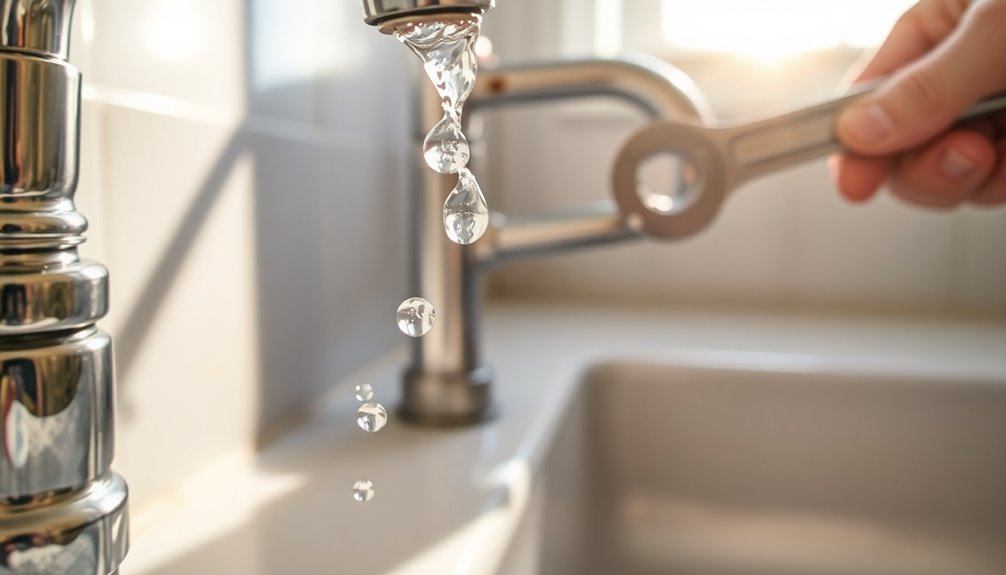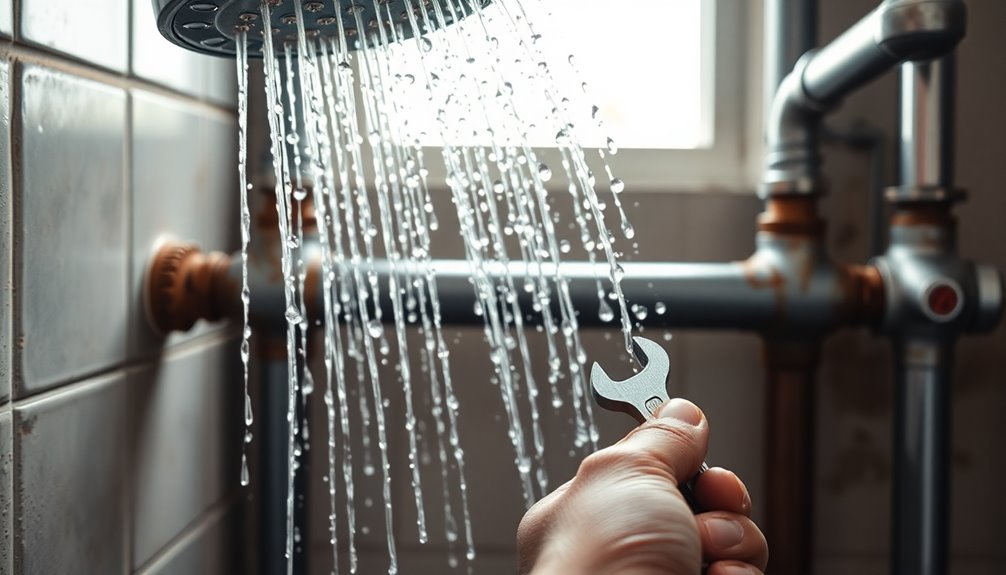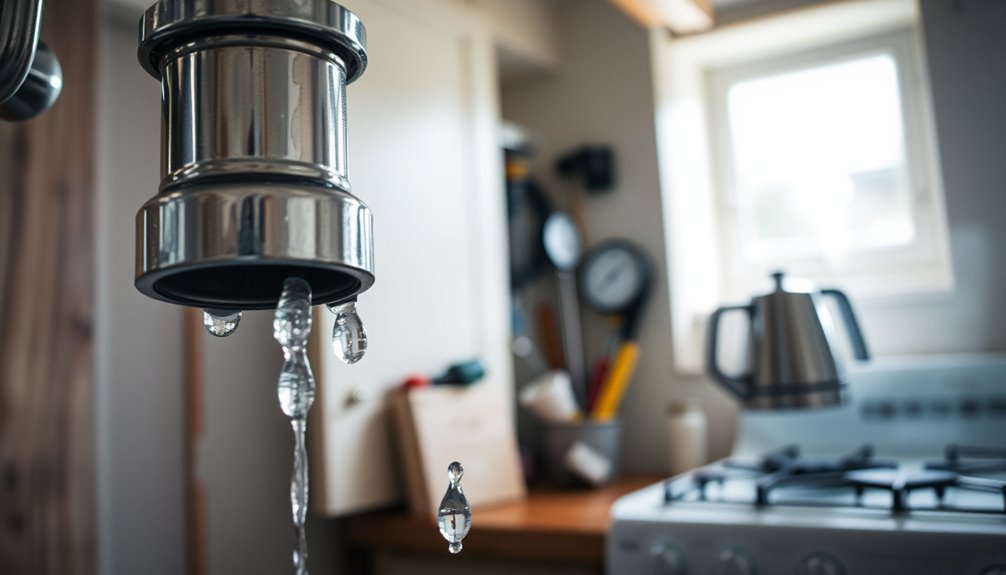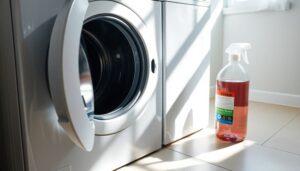If your water pressure is fluctuating, you're not alone; it's a common issue. It can be caused by leaks, clogged fixtures, or malfunctioning pressure regulators. Seasonal changes also play a role, affecting well pumps and pressure tanks. To address this, start by cleaning or replacing any clogged faucets and showerheads, and check your plumbing for leaks. Adjusting or installing pressure regulators can help stabilize flow. If problems persist, bigger pipes or a pressure booster system might be necessary. Keep exploring to discover more tips and tricks to manage your water pressure effectively.
Understanding Water Pressure Fluctuations
Understanding water pressure fluctuations is essential for maintaining a comfortable and functional home. These fluctuations can disrupt your daily routines, causing low water pressure or even sputtering faucets. The typical household water pressure ranges from 40-60 PSI, and when it falls outside this range, you may experience issues like variable shower pressure or strange banging noises in your plumbing system.
Several causes contribute to fluctuating water pressure. A malfunctioning pressure regulator can lead to inconsistent flow, while pipe leaks or clogged pipes restrict water movement, further exacerbating the issue. Additionally, budgeting tools can assist you in planning for any unexpected plumbing expenses that arise from these fluctuations. Understanding how expense tracking can help you budget for these repairs is crucial for proactive home maintenance.
Seasonal variations, such as increased demand during summer months or freezing temperatures in winter, can also affect your water pressure.
To combat these issues, consider regular monitoring of your water pressure with a gauge. This proactive measure allows for timely leak detection and helps identify any mineral deposits or buildup that may obstruct flow. Additionally, conducting routine plumbing system audits guarantees that your water heater and other components function effectively, minimizing the risk of pressure fluctuations. Implementing streamlined expense tracking can help you budget for necessary plumbing repairs and maintenance, ensuring your home remains in optimal condition.
Common Causes of Fluctuations
Fluctuating water pressure often has specific causes that can easily be identified and addressed. One common culprit is a defective pressure switch, which can fail to maintain consistent pressure levels in your system. Implementing clear payment terms can enhance trust and strengthen relationships with service providers when addressing these issues.
If you notice inconsistent water pressure, check your pressure tank, as a broken tank—often from a ruptured bladder—can lead to erratic water flow and pressure variations. Another issue to evaluate is high sediment or iron content in your water supply. This can foul pressure switches, contributing to fluctuating water pressure. Additionally, automated bill payment notifications can help ensure timely payments for any necessary repairs.
Furthermore, malfunctioning pressure relief valves (PRVs) that don't close properly can cause unexpected pressure spikes and drops, further disrupting your system's stability. If you're using a well pump, a damaged pump can lead to short cycling or constant running, which directly affects your water pressure.
These problems can manifest as noticeable fluctuations during use, making it essential to address them promptly. Utilizing bill tracking tools can help manage unexpected repair costs associated with these issues.
Diagnosing Pressure Issues

When tackling water pressure issues, start by measuring the pressure at various taps with a gauge to verify it falls within the normal range of 40-60 PSI.
If you notice water pressure problems, you'll want to identify the root cause before pursuing any affordable fixes.
Check for the following common culprits:
- Visible plumbing leaks that could be causing drops in pressure.
- Clogs in aerators or showerheads due to sediment or mineral deposits.
- A faulty pressure regulator that might lead to erratic pressure levels.
- Seasonal changes affecting your water supply, particularly if you're dealing with fluctuating well water.
Monitor for signs of fluctuating pressure during peak usage times, as this can lead to sputtering faucets and sudden drops in water flow. Utilizing expense tracking tools can be a smart way to manage the costs associated with plumbing repairs. Additionally, consider that regular monitoring of your expenses can contribute to a more stable financial situation, similar to how automated investment management helps track and optimize financial growth.
By systematically inspecting these areas, you can better diagnose the issue. Look for leaks, check the functionality of your pressure regulator, and clean any clogs.
Additionally, consider using expense management apps that can help you track costs associated with plumbing repairs, allowing you to budget effectively.
Addressing these factors will help stabilize your water pressure and prevent future issues.
Affordable Fixes for Stabilizing Pressure
After diagnosing the root causes of your water pressure issues, it's time to explore some affordable fixes that can help stabilize it.
Start by checking for clogged aerators and showerheads. Cleaning or replacing these can greatly improve water pressure stability and address one of the most common causes of fluctuations in water pressure. Additionally, maintaining regular expense tracking can help you allocate funds towards necessary home repairs and upgrades. Effective management of your finances can lead to timely repairs and prevent further complications.
Next, consider installing or adjusting pressure regulators, especially if you're connected to a municipal water supply. These devices help manage the pressure entering your home, ensuring a consistent flow.
Regularly inspect your plumbing system for leaks, as even small, undetected leaks can lead to considerable pressure drops.
If you're still experiencing issues, upgrading to larger diameter pipes can enhance water delivery and reduce constricted flow problems.
For homes with persistent low water pressure, implementing a pressure booster system can provide a consistent supply, particularly during peak usage times or when using hot water. Additionally, consider incorporating sustainable practices into your home maintenance routine, as they can contribute to overall efficiency and reduce long-term costs.
Preventative Measures and Maintenance

Maintaining consistent water pressure is essential for a comfortable home experience, and implementing preventative measures can save you from future headaches. Here are some effective steps to take:
- Regularly inspect and clean pipes, fixtures, and aerators to prevent clogs.
- Schedule annual maintenance checks for pressure tanks and well systems. Budgeting for maintenance can help ensure you have funds set aside for these essential services.
- Monitor your water usage patterns to avoid using multiple fixtures during peak times.
- Install pressure regulators and pressure tanks to enhance water pressure management. Regular maintenance can help you achieve enhanced control over your plumbing systems.
By focusing on these preventative measures, you can keep your plumbing systems running smoothly. Additionally, utilizing detailed insights and reporting from financial management tools can help you budget for necessary plumbing maintenance.
Regular maintenance, especially for your well pump and pressure tanks, guarantees they can handle seasonal demand changes.
Additionally, keeping an eye on water bills helps identify hidden leaks early, which can cause significant fluctuations in water pressure if left unchecked.
Conclusion
In summary, fluctuating water pressure can be a real headache, but you don't have to let it rain on your parade. By understanding the common causes and diagnosing the issues, you can implement affordable fixes to stabilize your water flow. Remember, a little maintenance goes a long way in preventing future problems. So, take action now, and you'll be enjoying consistent water pressure in no time—keeping your home running smoothly and stress-free!



